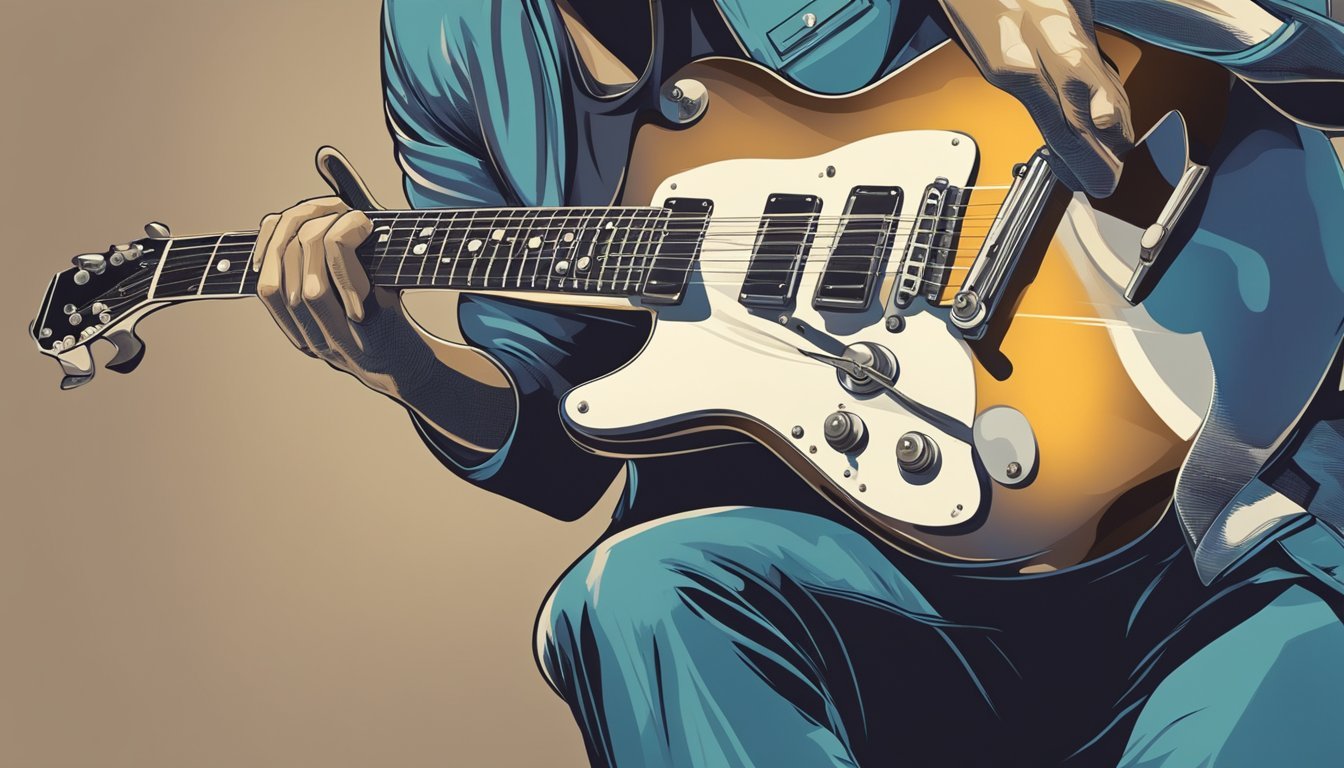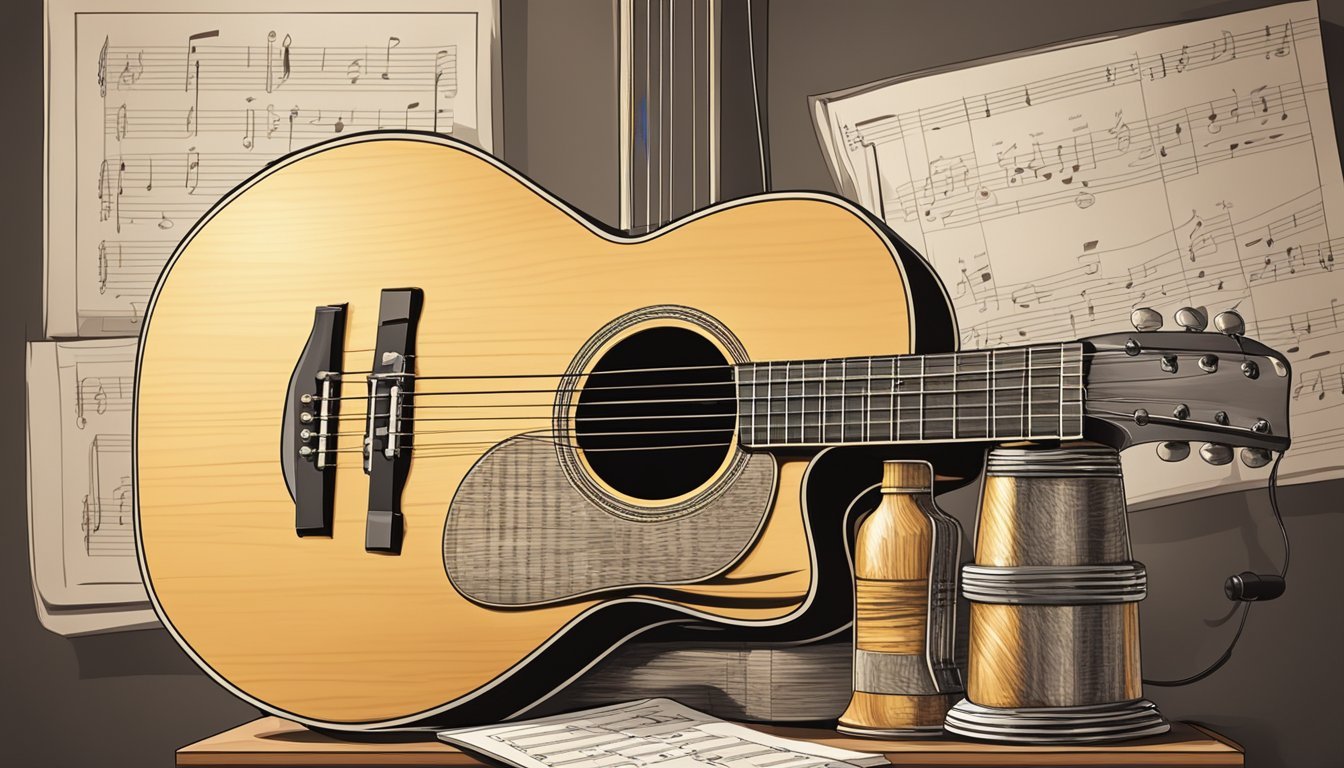The blues is more than just a music genre; it’s a heartfelt expression that can bring you joy and release.
To play blues on guitar, you need to understand basic chords and progressions, along with unique techniques that define this style.
Learning from the masters like Muddy Waters and B.B. King can inspire you on your journey, making the learning process not only educational but also fun.

Getting started with blues guitar might feel challenging at first, but with a few simple steps, you’ll find yourself playing tunes that resonate with your emotions.
Whether you’re strumming an acoustic guitar or jamming on an electric, those soulful notes are within reach.
With the right guitar lessons and practice, you can channel the sounds of legends like Eric Clapton and create your unique sound.
So, if you’re ready to dive into the world of blues, grab your guitar, and let’s unlock the secrets to playing this expressive music.
You’ll soon find this rich style will transform your playing and touch your soul.
Key Takeaways
- Understand basic chords and progressions for blues guitar.
- Learn essential soloing techniques to enhance your playing.
- Explore the influences of legendary blues artists for inspiration.
Getting Started with Blues Guitar
Before you jump into playing, it’s helpful to grasp the core of blues music and the gear you’ll need.
Understanding the genre and having the right equipment will set you up for success.
Understanding the Blues Genre
Blues music has roots in African American history and is all about expressing emotions.
It usually features 12-bar progressions, which are the backbone of many songs.
You’ll often find a mix of major and minor sounds that give it that unique feel.
The blues scale is essential for soloing.
It adds a “blue note,” which gives your playing a soulful touch.
The typical key for beginners is A, where you can find the notes A, C, D, E, and G. Keep these in mind as you learn riffs and licks, making each performance sound authentic.
Essentials of Blues Guitar Equipment
Choosing the right guitar can make a big difference in your sound.
An acoustic guitar is often great for beginners, as it’s easy to pick up and play.
However, an electric guitar gives you more options for tone and effects.
Consider adding these essentials to your setup:
- Guitar: Acoustic or electric
- Amplifier: For electric guitars, a good amp brings out your sound.
- Picks: Find a thickness that feels comfortable.
- Capo: Useful for playing in different keys without changing fingerings.
With these basics in hand, you’re ready to explore the world of blues music and develop your skills.
Mastering Blues Chords and Progressions
Playing the blues on guitar means getting comfortable with a few key chords and progressions.
The 12-bar blues structure, dominant 7th chords, and common turnarounds are essential for creating that classic sound.
The 12-Bar Blues Structure
The 12-bar blues is the backbone of many blues songs.
It typically follows a simple pattern that you can play in different keys.
Here’s the basic structure using the I, IV, and V chords:
- I chord (A): Play for 4 bars
- IV chord (D): Play for 2 bars
- I chord (A): Play for 2 bars
- V chord (E): Play for 1 bar
- IV chord (D): Play for 1 bar
- I chord (A): Play for 2 bars
In the key of A, you would play A7, D7, and E7.
This gives you a strong foundation to improvise and add your own flair.
Dominant 7th Chords in Blues
Dominant 7th chords are key in blues music.
They create a sense of tension that adds character to your playing.
The three main chords you’ll want to focus on are:
- A7
- D7
- E7
To build a dominant 7th chord, take the major chord and add a minor seventh.
For instance, the A7 chord is made up of A, C#, E, and G. These chords work together to create that classic bluesy feel, perfect for rhythm and lead guitar.
Common Blues Turnarounds
Turnarounds are short progressions that signal the end of a musical phrase.
They add excitement and lead back to the beginning of the progression.
Here are a few popular turnaround examples you can try:
- I – IV – I – V: Simple and effective.
- I – bVII – IV – V: Adds a nice twist.
- I7 – IV7 – I7 – V7: Classic blues feel.
Using chords like A7, D7, and E7 will help you nail these turnarounds.
Adding a turnaround at the end of your 12-bar progression keeps your playing dynamic and engaging.
Soloing Techniques for Blues Guitar
When you’re diving into blues guitar, mastering soloing techniques is key.
You’ll want to focus on scales, expressive techniques, and the unique sounds that define the blues.
Here’s what you need to know.
Using the Blues and Pentatonic Scales
The pentatonic scale is a must-know for blues players.
The minor pentatonic scale is especially popular.
It has five notes and creates a smooth, soulful sound.
To spice things up, try adding the blue note.
This note gives the pentatonic scale a bluesy feel.
When you play an A minor pentatonic scale, you’re using the notes A, C, D, E, and G. Add the blue note (Eb), and you get a blues scale, which enhances your solos.
Practice moving between scales.
For example, you can slide from the minor pentatonic to the blues scale during your solos.
This keeps your playing interesting and dynamic.
Expressive Guitar Techniques
Blues is all about expression.
Techniques like string bending can make your notes sing.
Start by pushing a string up or down to reach a higher note, creating tension.
Next up is vibrato.
This adds depth and warmth to your notes.
You do this by gently shaking the string after you hit a note.
It’s like giving your sound personality.
Don’t forget slides.
Sliding into a note can create a smooth transition that feels natural.
It’s great for connecting phrases in your solos.
Incorporate these techniques into your playing.
The combination of scales and expressive techniques will help you create memorable blues guitar solos.
Playing the Blues Like the Legends
To capture the true essence of blues guitar, you need to study the legends who shaped the genre.
Each artist brings their unique flavor, from Muddy Waters’ raw emotion to B.B. King’s expressive bends.
Pay close attention to their styles and signature licks.
Analyzing Styles of Blues Icons
Take some time to listen to blues legends like Robert Johnson and Buddy Guy.
Their playing tells stories just as much as their lyrics.
Muddy Waters often used a driving rhythm with strong, simple riffs.
His guitar playing has a gritty feel that resonates deeply.
B.B. King, known for his smooth, singing style, focused on expressive bends and vibrato.
You might also want to check out Eric Clapton.
He combined traditional blues with rock, creating powerful melodies.
John Mayer brings a modern twist while still honoring the roots of blues.
Experiment with these styles to find what speaks to you.
Incorporating Signature Licks and Riffs
Signature licks are a fundamental part of blues.
They convey emotion and connect you to the music.
For instance, B.B. King’s “Lucille” features a popular lick that you can learn to add to your playing.
Muddy Waters uses a rhythmic, choppy phrase that enhances the groove.
Don’t forget Robert Johnson’s blues licks that often include slides and pull-offs.
Try incorporating these elements into your solos.
You can also explore Buddy Guy’s improvisational style, which adds energy and spontaneity.
Eric Clapton and John Mayer often use similar techniques, bringing their signature twists.
Practicing these licks will help you establish your voice in the blues style.
Use them as a foundation and build your solos from there.
Frequently Asked Questions

When getting started with blues guitar, you probably have a lot of questions.
Let’s cover some basics about chords, tabs, rhythm, scales, easy songs, and tips for adding that special touch to your playing.
You’ll want to familiarize yourself with common blues chord progressions and the twelve-bar blues format, as these are foundational to the genre.
Learning how to play Tennessee whiskey can be a great way to practice, as it beautifully incorporates both rhythm and melody.
Additionally, exploring various scales, like the pentatonic scale, will help you improvise and add your own flavor to the music.
What are the basic blues chords for a beginner on guitar?
For beginners, the most common blues chords are E, A, and B7.
These chords form the foundation of many blues songs.
You can play them in a simple progression like E-A-B7 throughout the song.
Can you provide some simple blues guitar tabs for novices?
Sure! A simple blues riff you can try is in the key of E. Start with the open E string, then play the 2nd fret on the A string and the D string.
This basic pattern is a great way to get comfortable with playing blues.
How do you play blues rhythm on an acoustic guitar?
To play blues rhythm, focus on a shuffle feel.
Strum down on counts one and three, and lightly brush up on counts two and four.
This creates a relaxed swing that is key to blues rhythm.
Which blues scales are essential for playing blues solos on the guitar?
The minor pentatonic scale is essential for beginners.
In addition, adding the “blue note” from the blues scale gives your solos that distinctive sound.
For example, in the key of A, you’d include the E♭ note.
What’s the easiest blues song to start with for guitar learners?
A great beginner song is “Sweet Home Chicago.” It uses simple chords and basic 12-bar blues structure.
It’s fun and a perfect choice to practice your blues skills.
Are there any tips for adding emotion to blues guitar playing?
To add emotion, focus on your bends and slides.
Make your notes sing by playing them expressively.
Use dynamics.
Play some parts softer and others louder to create a more emotional feel in your music.

